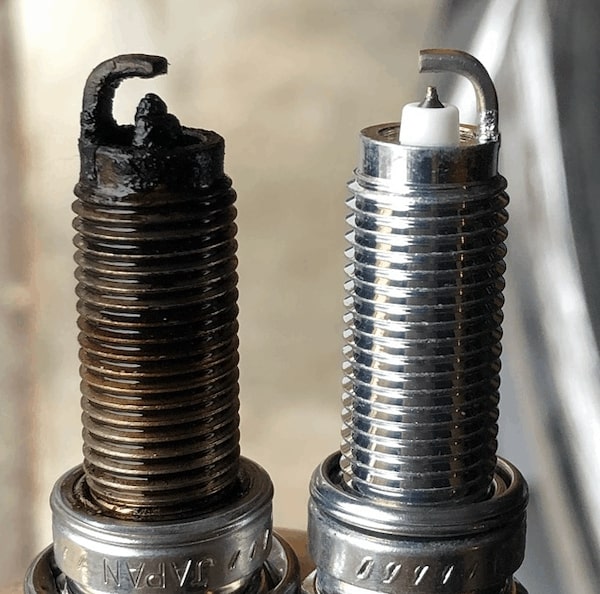
Signs of Bad Spark Plugs
When spark plugs begin to fail, they exhibit several distinct symptoms that can impact your vehicle’s performance.
- Rough Idle: A rough or bumpy idle can indicate your spark plugs are not firing properly. This inefficiency affects the engine rhythm.
- Misfires: Occasional engine misfires are a clear sign that your spark plugs may be dirty or worn out.
- Poor Acceleration: If you press the gas pedal and your car hesitates or accelerates sluggishly, consider checking your spark plugs.
- High Fuel Consumption: Worn spark plugs can reduce fuel efficiency. If you’re visiting the pump more often, it’s time to check your spark plugs.
- Difficulty Starting: Trouble starting your car might be due to spark plugs that need replacement.
Inspecting your spark plugs can reveal various issues:
- Physical Damage: Cracks or chips on the spark plugs are signs of damage.
- Carbon Deposits: Black, sooty deposits on the plugs suggest a rich fuel mixture or poor combustion.
- Oil Buildup: Oily residue indicates oil leakage into the combustion chamber.
- Wear and Tear: An electrode that is flat or worn down suggests the spark plug is past its prime.
Don’t Ignore Bad Plugs
Your vehicle’s performance can decline significantly if bad spark plugs are not replaced. This can lead to a range of issues that impair your vehicle’s efficiency and reliability.
Engine Misfires
- A misfire occurs when a spark plug fails to ignite the fuel-air mixture.
- You may notice sudden jolting during acceleration or a general lack of engine smoothness.
Poor Fuel Economy
- Worn or fouled spark plugs can’t efficiently burn fuel.
- You might see an increase in fuel consumption, hitting your wallet harder at the gas pump.
Difficulty Starting
- Bad spark plugs can lead to weak or inconsistent sparking.
- This often results in hard starts or your engine failing to turn over on the first try.
Inspection and Diagnosis

Proper inspection and diagnosis of spark plugs can reveal the health of your vehicle’s engine and indicate potential engine problems.
Visual Inspection
When you inspect a spark plug, you’re looking for several indicators that suggest wear or damage:
- Coloration: A healthy spark plug should have a light tan or grayish color. Dark, oily deposits indicate oil leakage, while black, sooty deposits suggest a rich fuel mixture or poor combustion.
- Wear: Check the electrodes for wear. They should be even and intact. If they are rounded or have uneven wear, it’s time for replacement.
- Damage: Look for cracks or chips in the insulator. If you notice any physical damage to the spark plug, it must be replaced immediately.
- Electrode Gap: Use a gap gauge to measure the gap between the electrodes. The incorrect gap can cause misfires. Your vehicle’s service manual will provide the correct specifications.
Performance Tests
Conduct a few tests to assess spark plug performance:
- Spark Test: Use an ignition tester to check if the spark is strong and consistent. A weak or inconsistent spark indicates that the spark plug may need replacement.
- Engine Idle: A rough or irregular engine idle can signal spark plug issues. Healthy spark plugs contribute to a smooth and steady idle.
- Acceleration Test: Hesitation or stumbling during acceleration often points to failing spark plugs.
- Misfire Detection: Use an onboard diagnostics scanner (OBD-II reader) to check for misfire codes. Misfire codes can often lead to a specific cylinder’s spark plug.
Replacing Spark Plugs
When it’s time to replace your spark plugs, selecting the appropriate type and ensuring correct installation are crucial for optimal engine performance.
Choosing the Right Spark Plugs
- Review your vehicle’s manual: Locate the specification for spark plugs to determine the correct type and gap setting.
- Consider your driving needs: Select from standard, platinum, or iridium plugs based on your vehicle’s requirements and performance goals.
Installation Process
- Gather necessary tools: You’ll need a spark plug socket, ratchet, extension, torque wrench, and gap gauge.
- Pre-installation steps:
- Disconnect the battery for safety.
- Remove any debris around the spark plug area to avoid contamination.
- Installation steps:
- Remove the old spark plugs using the spark plug socket and ratchet.
- Use the gap gauge to ensure the new spark plug gap matches your vehicle’s specifications.
- Install new spark plugs by hand at first to prevent cross-threading, then tighten with a torque wrench to the manufacturer’s recommended torque setting.
- Reattach any cables or connectors that were removed during the process.
- Reconnect the battery and start the vehicle to check for proper installation.




